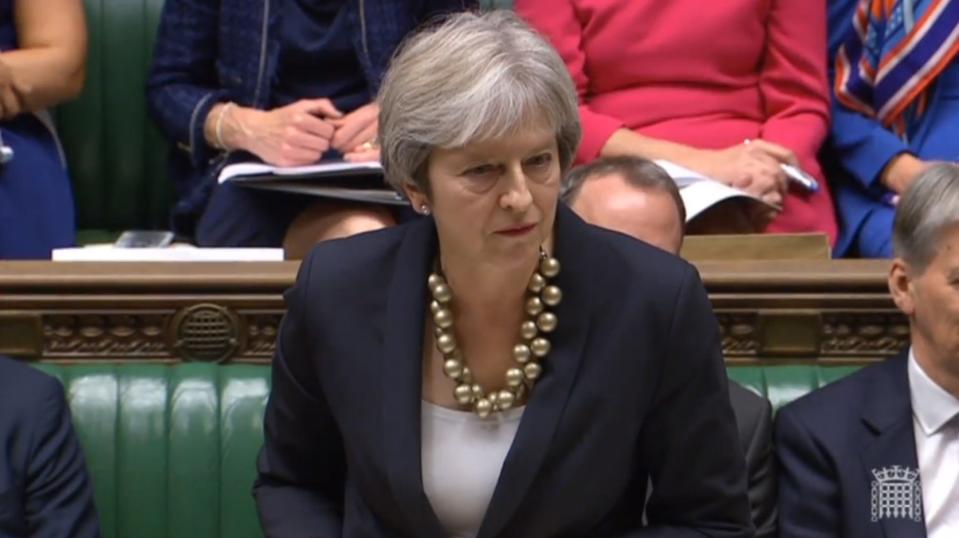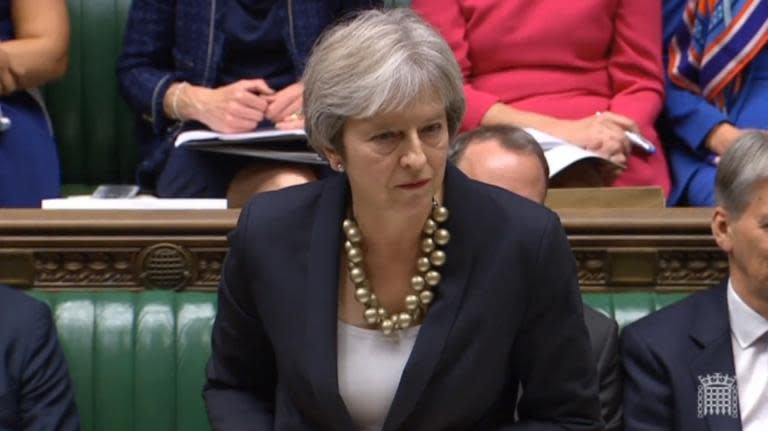Theresa May sidesteps Tory rebellion by announcing plans to enshrine her Brexit proposals in law
Theresa May has sidestepped a Brexit rebellion from Eurosceptic Tories threatening to seize control of a key part of her negotiating strategy.
The prime minister said she would make the UK’s proposals for the Irish border after Brexit legally binding, claiming this would negate the need for the EU’s alternative, which is hated by Eurosceptic rebels.
She also argued there had been a “substantial shift” in the EU’s willingness to engage with her ideas on the problem of the Irish border.
In a sign that her words had won at least a temporary reprieve, rebels withdrew a plan to forcefully cut off some of her negotiating options in a Commons vote later this week.
But rumours still circulated that senior figures in her party, including ex-cabinet minister David Davis, are manoeuvring ahead of a potential leadership challenge.
The prime minister was addressing MPs following the European Council last week, telling them a “considerable” sticking point remained over how to keep the Irish border open if, after the Brexit transition period ends in December 2020, no plan for future relations between the UK and EU are agreed.
She set out steps to break the impasse, the first of which would be to enshrine in law her UK “backstop” plan for that scenario which would keep the whole UK in a temporary customs union with the EU.
Ms May argued this would mean the EU’s alternative backstop – keeping Northern Ireland alone under Brussels’ customs union, with a customs border put down the Irish Sea – would no longer be needed.
The prime minister also repeated comments indicating the UK would consider temporarily extending the transition period to provide more time to negotiate.
The Independent understands that the government would seek to extend the transition if only a few months was needed to secure the final deal on future relations after December 2020, but would opt to move to the UK backstop plan if a longer period was needed – officials underlined that under the PM’s proposals both paths would be time limited to ensure the UK did not remain tied to EU customs rules indefinitely.
Ms May said: “Let us remember that all of these steps are about insurance policies that no one in the UK or the EU wants or expects to use.
“So we cannot let this become the barrier to reaching the future partnership we all want to see.
“We have to explore every possible option to break the impasse and that is what I am doing.”
Ms May’s move to enshrine the UK backstop plan in law appeared to placate ex-Brexit minister Steve Baker who had planned to force a vote on a rebel motion on Wednesday that would have effectively made the EU’s backstop plan illegal.
If passed it could have restricted Ms May’s room for manoeuvre in Brussels, but Mr Baker backed down on Monday afternoon.
Other Brexiteers did raise questions about her suggestion of elongating the transition period, with former cabinet minister John Redwood warning it could cost the UK up to £20bn extra on top of the £39bn EU divorce bill.
Ms May will meet the cabinet amid the high tension and give them an update on negotiations on Tuesday, with at least three of her top ministers said to have been considering quitting over her approach.
The prime minister also looked set to avert a potentially bruising meeting with the powerful backbench 1922 Committee, with Conservative chairman Brandon Lewis going to represent the leadership instead.
One Brexiteer had suggested that if she went to the meeting she should “bring her own noose” while an ally of former cabinet minister Mr Davis had suggested ahead of the meeting that she was now in the “killing zone”.
The unsavoury language was condemned in the house by many MPs, including Ms May’s critics, giving her another small victory over her opponents.
Mr Davis was however still said to be in the process of laying the ground for a potential leadership challenge, if Ms May’s unstable administration begins to crumble.

 Yahoo News
Yahoo News 

